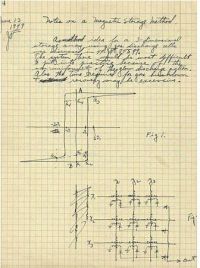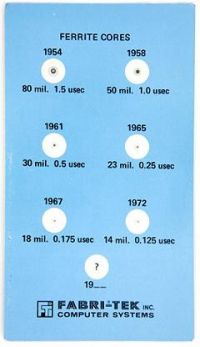
magnetizer
tarakan2, Sat Jul 13 2013, 06:56PMHello
This article describes a process of making a magnet by mixing ferromagnetic substance with resins and than using a circuit that would apply AC and DC magnetic fields to the mix, at the same time.

Why?
I am not asking about your overall opinion on the legacy of Searl Effect and I am not building this device.
I am interested in logic behind using AC.
Is this to make particles move around more so they rearrange themselves within the resin as it hardens?
If I make a torus magnet with resin and iron powder and try to magnetize it by winding wire over a mold and forcing current through it in one direction, what would I get? (wind it same way toroidal chokes are wound)
When it cures, I will get a magnet where flux will go around the ring and no poles will appear on the outside?
Re: magnetizer
Proud Mary, Sat Jul 13 2013, 09:51PM
There is no 'Searl Effect': it is a 'free energy' swindle.
Proud Mary, Sat Jul 13 2013, 09:51PM
There is no 'Searl Effect': it is a 'free energy' swindle.
Re: magnetizer
klugesmith, Sun Jul 14 2013, 12:44AM
Yup. In fact, that will work on a torus of any magnetically "hard" material. You can permanently magnetize the ring with flux going around the ring, and no poles anywhere.
In case anyone wonders what good that would be ... it was the most common form of computer memory in the decades before semiconductor RAM was invented. One ring per bit, magnetized with the flux running one direction for "0" and the other direction for "1". Pretty compact for those days, with rings (cores) on the order of 1 mm in diameter, in spectacular 3-dimensional arrays.
Now can anyone who doesn't already know the answer, and without looking on the Internet, figure out how to electronically read the state (the direction of magnetization) of a core?
klugesmith, Sun Jul 14 2013, 12:44AM
tarakan2 wrote ...
...If I make a torus magnet ... and try to magnetize it by winding wire over a mold and forcing current through it in one direction, what would I get? (wind it same way toroidal chokes are wound)
...will I get a magnet where flux will go around the ring and no poles will appear on the outside?
...If I make a torus magnet ... and try to magnetize it by winding wire over a mold and forcing current through it in one direction, what would I get? (wind it same way toroidal chokes are wound)
...will I get a magnet where flux will go around the ring and no poles will appear on the outside?
Yup. In fact, that will work on a torus of any magnetically "hard" material. You can permanently magnetize the ring with flux going around the ring, and no poles anywhere.
In case anyone wonders what good that would be ... it was the most common form of computer memory in the decades before semiconductor RAM was invented. One ring per bit, magnetized with the flux running one direction for "0" and the other direction for "1". Pretty compact for those days, with rings (cores) on the order of 1 mm in diameter, in spectacular 3-dimensional arrays.
Now can anyone who doesn't already know the answer, and without looking on the Internet, figure out how to electronically read the state (the direction of magnetization) of a core?
Re: magnetizer
Conundrum, Sun Jul 14 2013, 11:48AM
Yeah, the Searl effect is about as crazy as ant!grav!ty using spinning superconductors.
That said, the OP did mention some interesting ideas which could be adapted for making positioners on RepRaps.
Re. reading, IIRC they used hysteresis ie the current in one direction is different to the current in the other, due to the Left Hand Rule.
-A
Conundrum, Sun Jul 14 2013, 11:48AM
Yeah, the Searl effect is about as crazy as ant!grav!ty using spinning superconductors.
That said, the OP did mention some interesting ideas which could be adapted for making positioners on RepRaps.
Re. reading, IIRC they used hysteresis ie the current in one direction is different to the current in the other, due to the Left Hand Rule.
-A
Re: magnetizer
Ash Small, Sun Jul 14 2013, 12:06PM
Did they use a second wire through the toroid for reading, or the same wire used for magnetising?
Ash Small, Sun Jul 14 2013, 12:06PM
Conundrum wrote ...
Re. reading, IIRC they used hysteresis ie the current in one direction is different to the current in the other, due to the Left Hand Rule.
-A
Re. reading, IIRC they used hysteresis ie the current in one direction is different to the current in the other, due to the Left Hand Rule.
-A
Did they use a second wire through the toroid for reading, or the same wire used for magnetising?
Re: magnetizer
Conundrum, Sun Jul 14 2013, 02:15PM
I think so, it was so that reading didn't affect the stored data.
In fact MCM is making a comeback, its now called "Magnetoresistive memory".
Conundrum, Sun Jul 14 2013, 02:15PM
I think so, it was so that reading didn't affect the stored data.
In fact MCM is making a comeback, its now called "Magnetoresistive memory".
Re: magnetizer
klugesmith, Mon Jul 15 2013, 08:05PM
Re. reading data from magnetic cores.
Apparently the seminal patents are from 1947 and 1949, with X-Y addressing added in 1951.
Here is a blog from 2011 of some people who, for the 60th anniversary, made a working 32-bit core memory array -- as an Arduino shield.
That confirmed my recollection of how to read the state of a stationary permanent magnet with no poles.
Faraday discovered that magnets can induce electricity, but only by having a CHANGE in flux linkage.
Suppose the core with unknown state has been threaded with a write winding and a read winding.
Step 1:
Energize the write winding, to write a zero. At the same time, monitor the voltage on the read winding.
If the flux was originally near saturation in the zero direction, it just stays that way.
If the flux was originally near saturation in the one direction, then it reverses, and that induces a voltage pulse in the read winding.
Step 2.
If the read result is 1, then immediately write the core back to the 1 state.


from
klugesmith, Mon Jul 15 2013, 08:05PM
Re. reading data from magnetic cores.
Apparently the seminal patents are from 1947 and 1949, with X-Y addressing added in 1951.
Here is a blog from 2011 of some people who, for the 60th anniversary, made a working 32-bit core memory array -- as an Arduino shield.

That confirmed my recollection of how to read the state of a stationary permanent magnet with no poles.
Faraday discovered that magnets can induce electricity, but only by having a CHANGE in flux linkage.
Suppose the core with unknown state has been threaded with a write winding and a read winding.
Step 1:
Energize the write winding, to write a zero. At the same time, monitor the voltage on the read winding.
If the flux was originally near saturation in the zero direction, it just stays that way.
If the flux was originally near saturation in the one direction, then it reverses, and that induces a voltage pulse in the read winding.
Step 2.
If the read result is 1, then immediately write the core back to the 1 state.


from

Print this page